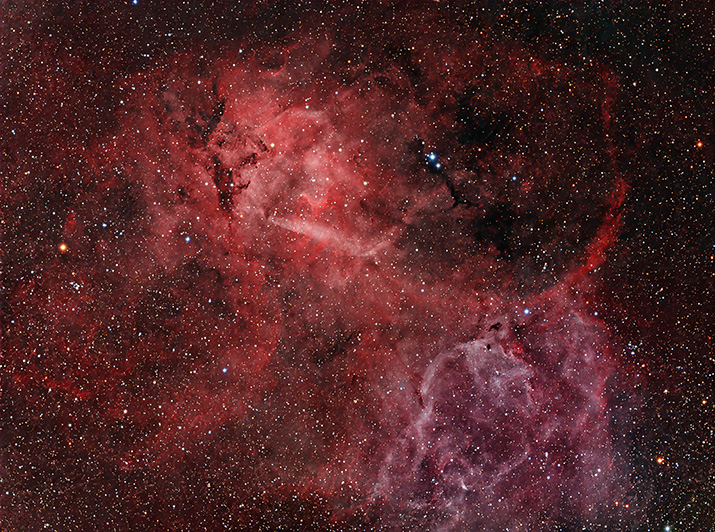
|
Date: Oct.26, 2025 - Location: Dark Sky Observatory - Fort Davis, Texas Telescope: Officina Stellare f/3 RH200-AT - Mount: Paramount MX - Camera: QSI-640 Exposure: Ha & OIII = 15x5 min. each R,G,B for stars = 20x30s min. each Click on the image to view at higher resolution. |

|
Sh2-132, as designated in the Sharpless catalog, is a relatively faint emission nebula located approximately 10,000 to 12,000[1] light-years away in the constellation Cepheus, near the border with Lacerta[1]. This H II region spans physical diameter of approximately 250 light-years[1]. The nebula is primarily ionized by two massive Wolf-Rayet stars[2,4]: WR 152 and WR 153ab (a binary system)[1]. These extremely hot and luminous stars expel powerful stellar winds at velocities up to 2,400 km/s[2,4], carving cavities and shock fronts into the surrounding gas. The brightest condensation near WR 153ab is sometimes called the "Lion's Head," ( Upper left in the image) with a prominent dark lane of dust sculpting the appearance of facial features. These features evoke a lion's profile with the head to the upper left and body extending to the right. Narrowband imaging in Ha (red) and [OIII] (blue-green) reveals the nebula's bipolar structure: Ha dominates the central and south west regions, while [OIII] is strongest in two compact knots near the Wolf-Rayet stars, especially the lower-right OIII dominated bluish cavity around WR 152[3,4]. This image is a bi-color narrowband composite created by mapping hydrogen-alpha (Ha) emission to red and doubly ionized oxygen (OIII) emission to both green and blue. Red, Green, and Blue filtered star data was then layered into the image to provide a natural stellar background. This technique, often called HOO mapping, highlights the ionization structure of the nebula while preserving the realistic star field colors, making it a valuable approach on a scientific level as well as aesthetic imaging. A Hubble Palette (SHO) version of the Lion Nebula may be view here.
Member of the Dark Sky Observatory Collaborative
References
|